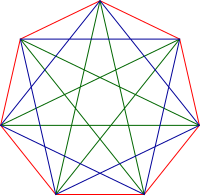Heptagon: Difference between revisions
m Reverted edits by 24.151.136.119 (talk) to last version by Sopoforic |
AndrewKepert (talk | contribs) remove image and surrounding table, reinstate neusis image - see Heptagon:talk |
||
| Line 26: | Line 26: | ||
trisector. The impossibility of straightedge and compass construction follows from the observation that 2cos(2 |
trisector. The impossibility of straightedge and compass construction follows from the observation that 2cos(2 |
||
| ⚫ | |||
{| class="wikitable" width=480 |
|||
|valign=top|[[Image:Heptagonbuilding.png|320px]]<BR>Construction of a hepatagon by dividing a given circumference in seven equal parts. |
|||
| ⚫ | |||
|} |
|||
== Heptagrams == |
== Heptagrams == |
||
Revision as of 10:08, 5 September 2007
| Regular heptagon | |
|---|---|
 A regular heptagon | |
| Edges and vertices | 7 |
| Schläfli symbol | {7} |
| Coxeter–Dynkin diagram | |
| Symmetry group | Dihedral (D7) |
| Area (with t=edge length) |
|
| Internal angle (degrees) |
1285/7° |
In geometry, a heptagon is a polygon with seven sides and seven angles. In a regular heptagon, in which all sides and all angles are equal, the sides meet at an angle of 5
The heptagon is also sometimes referred to as the septagon, using "sept-" (an elision of septua-, a Latin-derived numerical prefix, rather than hepta-, a Greek-derived numerical prefix). It is in some dictionaries.
Construction
A regular heptagon is not constructible with compass and straightedge but is constructible with a marked ruler and compass. This type of construction is called a Neusis construction. It is also constructible with compass, straightedge and angle
trisector. The impossibility of straightedge and compass construction follows from the observation that 2cos(2

Heptagrams
Two kinds of heptagrams can be constructed from regular heptagons, labeled by Schläfli symbols {7/2}, and {7/3}, with the divisor being the interval of connection.

Blue, {7/2} and green {7/3} heptagrams inside a red heptagon.
Uses
The United Kingdom currently (2006) has two heptagonal coins, the 50p and 20p pieces, and the Barbados Dollar is also heptagonal. The 20 eurocent coin has cavities placed similarly. Strictly, the shape of the coins is a curvilinear heptagon to make them curves of constant width: the sides are curved outwards so that the coin will roll smoothly in vending machines. The Brazilian 25 cents coin has a heptagon inscribed in the coin's disk.
See also
External links
- Definition and properties of a heptagon With interactive animation
- Approximate construction method
- Weisstein, Eric W. "Heptagon". MathWorld.



